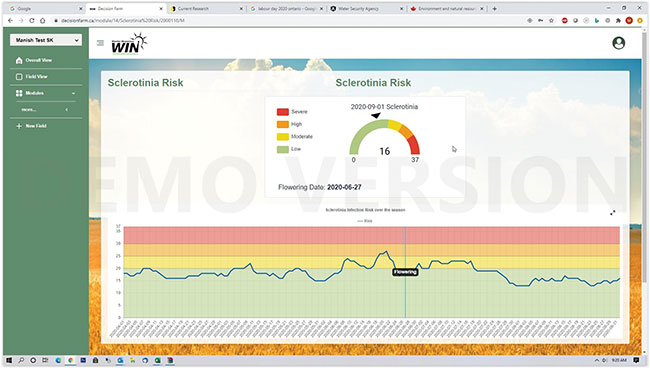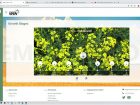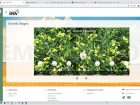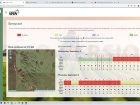
Features
Diseases
Canola
A new forecasting tool for Sclerotinia risk
A new web-based tool provides growers with decision support for forecasting canola growth stage and Sclerotinia risk in Western Canada.
November 28, 2020 By Donna Fleury
 Screenshot showing risk of Sclerotinia infection.
Photos courtesy of Weather INnovations Consulting LP.
Screenshot showing risk of Sclerotinia infection.
Photos courtesy of Weather INnovations Consulting LP.
Sclerotinia stem rot is a highly unpredictable and weather dependent disease. It’s an ongoing concern in all canola-growing areas of Canada. Although foliar fungicides remain the main control strategy at flowering, the variability in disease occurrence and severity, and narrow window for fungicide application, add to the complexity of managing risk.
A collaborative research project led by Weather INnovations Consulting (WIN) was initiated to develop reliable Sclerotinia stem rot risk and canola growth stage forecasting models. Along with risk assessment, the models would also provide an estimated date when the canola would reach 14 different growth stages. Once developed, these models will provide canola growers with decision support to apply or forgo fungicide application.
The five-year project included both small-scale experimental trials and large-scale field trials at multiple locations across three Prairie provinces during 2013 to 2017 to collect site-specific disease, agronomic and weather data. The project was led by Rishi Burlakoti and Neal Evans from WIN in collaboration with researchers from the University of Manitoba and Agriculture and Agri-Food Canada (AAFC) Saskatoon. The field trials also included industry partners Bayer Crop Science and Indian Head Agricultural Research Foundation (IHARF), with funding from the Canola Council of Canada.
“The replicated small plot trials included three canola varieties representing short-, mid- and long-season cultivar groups, while the field-scale trials had one cultivar,” explains Burlakoti, a research scientist currently with AAFC in Agassiz, B.C. “We installed time-lapse cameras at all sites to record pictures of canola growth stages each day, along with manual observations once a week. Weather data from each field was also recorded. Sclerotinia disease was monitored periodically after flowering stage until swathing was completed. We also included sclerotia depots developed by AAFC researcher Lone Buchwald and counted sclerotia germination of apothecia at one location in Manitoba.”
The model development was based on the data collected from the field trials and also considered the principles and factors used by Sclerotinia models developed in other areas, such as in France, Sweden, Western Canada and the USA. The model also considered agronomic factors, such as previous crop history, disease history, plant density, varietal resistance and weather factors, such as temperature, number and frequency of rainfall and daily wetness hours. Accumulated growing degree days, physiological days and crop heat unit (CHU) models were compared for 14 selected crop stages from emergence (BBCH 9) to ripe (BBCH 89).
“We selected physiological days as the best model for predicting the phenology or growth stages for short-, mid-, and long-season varieties,” says Manish Patel, president of WIN. “Our model is unique in that it includes an integrated forecasting model to predict critical growth stages during flowering (BBCH 60 and BBCH 65), which is the most critical stage for the pathogen to infect the crop.
“The model uses weather data during flowering stage (-2 to +2 weeks of BBCH 65), combined with the various agronomic factors, to calculate the infection risk of Sclerotinia stem rot. The weather data is refreshed on an hourly basis using our own WIN networks and freely available data from other services like Environment Canada. We rely on about 3,600 weather stations across the Prairies and in Ontario on a grid of about four by four kilometres, which are integrated with a GIS system to provide field-specific information.”
Patel adds, “We are partnering with IBM on weather forecasting, as they have the computing power and resources to run weather forecasting on an hourly basis, as compared to other traditional resources that typically only run every six or 12 hours.”
Canola growers can register for free on the website and get site-specific forecasting of Sclerotinia infection risk. Basic information, such as planting date, cultivar, soil type and number of years canola was planted over the past six years in rotation with other crops is required. This platform, developed by WIN, will compile field-specific observed weather data and forecasted weather data, which is then fed into the model. Based on the information supplied by the end-user and both historic and forecasted weather, the model determines the risk base for the end-user, showing as a colour risk dial of green, yellow or red, depending on risk level.
The Sclerotinia model is integrated with the growth stage model, and these models will help canola growers make fungicide spray decisions in managing Sclerotinia stem rot. The model will also reduce the number of unnecessary sprays if weather conditions are not suitable for disease development, which will ultimately help to reduce the environmental impact.
“Growers can register their fields as soon as the field is planted or later – as long as it is before flowering and the correct planting date is provided,” Patel explains. “The system monitors and integrates the observed weather for the specific site and provides the phenology of the crop. Growers can actually monitor their crop from planting date through to harvest with the platform. The model will forecast when the crop will begin flowering around BBCH 59-60, which is when growers should also start scouting their crop in the field to see how it is progressing.
“The system provides information at different stages of the crop – from the start of flowering, through different per cent levels of flowering to the end, and the risk of infection every day. If growers start scouting their field and see that the model doesn’t quite match, such as it shows the crop is just starting to flower but the field is more advanced, growers can go into the website and change the information, which will reset the model. The grower could then use this information towards the decision-making process for the field in terms of spraying. WIN also provides supplemental tools, such as SPRAYcast, that could be used to determine the ideal conditions for spraying as well.”
Although the Sclerotinia model is currently only available for canola, there will be future opportunities to expand to other crops, such as soybeans and dry beans, in which Sclerotinia stem rot is a significant concern. Growers will find the growth stage tools useful for other agronomic operations, such as spraying herbicides, identifying key growth stages for pest damage and swathing. WIN also has a BINcast model that helps monitor crops after harvest in bin storage, providing current ECM conditions as well as a forecast for the next five days.
“One of the things that sets this model apart is that the information and data is regularly updated and the models are retrained,” Burlakoti says. “Weather conditions and observations can be variable, and Sclerotinia is highly variable with lots of microclimate differences, so it is important to retrain the model based on additional research information. As new cultivars are registered, they are added to the model. Regular updating of new data and research information from researchers and agronomists helps to keep the model highly accurate.”
“We are also working closely with Lone Buchwald at AAFC to explore funding opportunities to create a dedicated app for both Android and Apple for this tool,” Patel adds. “At WIN we believe in keeping our tools free for agriculture end-users, so farmers have free access to the range of tools available. We work on B2B relationships in terms of sponsorship for the tools with various industry partners.
“Growers can access this new Sclerotinia web-based risk tool for free at www.canoladst.ca or at WIN’s www.decisionfarm.ca, where additional free tools are also available for growers to plot various crop fields and receive field and crop-specific advisories for various factors, such as pests, diseases, growth stage, optimal storage conditions and other risks.”


